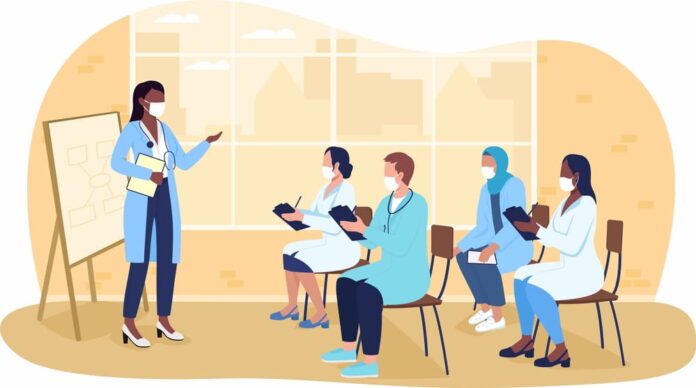The curriculum of a nursing school gets constantly reviewed for relevance. While the basic care principles will always remain, new advances in technology and procedures can make nurses and doctors more effective than ever before.
That makes it vital that some forms of training are not only required of all nurses but that a general proficiency among current nurses be established and maintained. Doing this might even require retraining for those who aren’t up to date with current practices.
One area that falls into that category is cardiac arrhythmia. While it is very prevalent and often indicative of other health problems, not all training curriculum provides the proper scope for interpretation of cardiac rhythms, principles of cardiac anatomy, and appropriate treatment methodology. Here are some key reasons cardiac arrhythmia training is so crucial to those studying to be nurses and nurses who are already practicing.
Cardiac Arrhythmia Is Common Across All Patients
Many diseases or health abnormalities are age-focused. Cardiac arrhythmia is age indiscriminate. It can happen to the young and old, sick and well. It also can frequently occur, be a permanent issue for a patient, or happen only occasionally. For many people, a single experience is the only extent that they will have to deal with a health issue.
Because it is so prevalent and can be present across ages, training in the curriculum is vital if for no other reason than nurses can put a patient’s mind at ease if they have an arrhythmia. Nurses can also observe when it happens to patients and determine if it should be brought up to the attending physician or noted in the patient’s medical record.
Nevertheless, even though it is a common condition, not many nurses are proficient in treating or recognizing it. Many who have taken arrhythmia interpretation classes have forgotten what to do because it is rare that a cardiac arrhythmia is a regular occurrence with a patient.
When that happens, though, understanding what it means can be vital. Knowing how to interpret an arrhythmia is particularly important because it affects many people across many walks of life.
A Comparison
Consider two patients in a health clinic, both of whom have issues with their heart rhythms. One is sick with an underlying disease, while the other is decently healthy outside of why they are at the clinic. A temporary arrhythmia in the latter patient might not raise eyebrows or even warrant any consideration by a nurse.
The other patient, however, could be a completely different story. Their arrhythmia might be indicative of their health issue or an indicator that their condition has worsened. It could also indicate that they are on the verge of a health emergency.
A nurse with no arrhythmia training might not understand what is happening or why it might be of importance. The nurse might not pay any attention to what could be a red flag of a major health issue. Because arrhythmia is so common, it pays to have nurses trained in a basic understanding of the issue and how to interpret it.
Cardiac Arrhythmia Training Can Save a Life
As mentioned, an arrhythmia can be an indication of a more serious emergency that is looming. A patient, for example, might be on the verge of a stroke or heart attack. The arrhythmia might be the only way the patient’s body reacts to whatever has pushed them towards that health crisis.
Worse, being able to interpret abnormal heart rhythms and whether more intensive medical treatment is warranted could be the difference between that patient living or dying. A trained nurse would recognize the potential danger and take appropriate actions. An untrained nurse might not realize anything was amiss until the health crisis erupted.
There is also no downside to completing training or retraining in interpreting the various issues stemming from problematic heart rhythms. The training often involves practicing on cardiac rhythm practice strips and is easy for most nurses to pick up. Rhythm strip interpretation is something that practicing nurses can quickly refresh or learn and may count towards their continuing education requirements.
Cardiac Arrhythmia Can Be a Symptom
That brings up the next point: a cardiac arrhythmia can signal an even more serious health problem. A cardiac arrhythmia can indicate that a person has or had:
- A heart attack
- Damaged heart tissue
- Blocked arteries
- High blood pressure
- Structural changes because of heart issues like cardiomyopathy
- Thyroid gland issues (over and under active)
- Alcohol and drug overdose
- Excessive intake of caffeine
- Diabetic complications
- An imbalance of electrolytes (potassium, magnesium, sodium, calcium, etc.)
- A reaction to certain medications
Any of these could lead to cardiac arrhythmia, or the cardiac arrhythmia could indicate that the underlying issue is impacting the body in unanticipated ways.
An arrhythmia might not be the only indicator in most patients with any of those conditions. In some cases, however, it might. Knowing how to interpret an arrhythmia may prompt a nurse to request more intensive medical intervention, which could save a patient’s life.
Not being up-to-date in training or knowing how to interpret an arrhythmia can lead to the patient’s condition not being caught in time. For example, someone with clogged arteries and arrhythmia might not exhibit classic heart disease symptoms. The arrhythmia might be the only indicator that something else is wrong.
Read Also
- Creative Approaches to Alleviating Healthcare Staff ShortagesHospitals and clinics are facing staff shortages, which makes it harder to take care of patients well. Finding simple and useful solutions is very important. Easy changes like flexible work hours, good training, and chances to grow can help staff stay happy. Technology, like online doctor visits and helpful tools, can make work easier. Smart… Read more: Creative Approaches to Alleviating Healthcare Staff Shortages
- Understanding the Role of Sterilizers in Healthcare FacilitiesHave you ever wondered how hospitals keep their equipment safe enough to use on dozens of patients every day? Most people never think about what happens behind the scenes, yet these hidden steps play a huge role in patient safety. Sterilizers are part of that system, working quietly to remove harmful germs before any instrument… Read more: Understanding the Role of Sterilizers in Healthcare Facilities
- Building Healthcare Access Where It’s Needed Most: A Local First ApproachHealthcare shouldn’t depend on where you live. But in the U.S., it often does. If you’re in a big city, you likely have options. If you’re in a small town or an underserved neighbourhood, it’s a different story. To fix this, more healthcare leaders are turning to a local-first approach. That means putting clinics and… Read more: Building Healthcare Access Where It’s Needed Most: A Local First Approach
- Revolutionizing Patient Engagement: Innovative Solutions for Improved Care and Treatment SuccessNavigating healthcare system can often feel overwhelming for patients. Between appointments, prescriptions, and treatment regimens, it’s easy for crucial details to get lost in the shuffle. That’s why effective patient engagement and support solutions are more important than ever. Companies like Serva Health, with their pharma hub services, are stepping up to ensure that patients… Read more: Revolutionizing Patient Engagement: Innovative Solutions for Improved Care and Treatment Success
- On-Demand Healthcare Staffing As A Cost-Saving StrategyThis is an exciting and challenging time for the healthcare industry. Technology is advancing almost faster than humans can keep pace. New legislation is creating fresh challenges for the future of healthcare, and the shifting population demographic continues to place more pressure on healthcare facilities. Amidst these changes, healthcare facilities are facing a critical staffing… Read more: On-Demand Healthcare Staffing As A Cost-Saving Strategy
There Is a Need
Because arrhythmia is so prevalent and does not discriminate based on age or medical condition and might indicate something more serious, understanding how to recognize and interpret life-threatening arrhythmia is vital to a nurse’s duty.
The patient is already at a medical facility, so it is reasonable to assume that additional medical symptoms could mean something more serious. If the arrhythmia happened in a perfectly healthy patient, a nurse or doctor might get away with writing it off as a health anomaly. The patient’s status, however, escalates the presence of any other symptoms.
At the very least, the presence of arrhythmia tips off that something is amiss with the patient. That might be because of their condition or indicative of some other health issue or looming crisis. Further, it might mean that that patient should be looked at more closely and monitored for other symptoms.
A nurse trained in interpreting arrhythmias will understand that, at the least, they should keep an eye on the patient. Often treatment will require serious electric or pharmacologic therapy. An untrained nurse or nurse whose training was many years ago may not pick up on the arrhythmia or its potential importance.
The other risk is that the patient complains about arrhythmia and the nurse brushes it off as a “heart flutter.” The nurse is not to blame if their training did not cover what it might mean and when they should pay more attention. Even if it turns out to be nothing, recognizing it and being able to interpret it might prompt further attention for that patient.
Nursing and Healthcare Best Practices
The purpose of nurses is to aid patients, often serving as the “front line” monitor of a patient’s condition. Serving in that status is particularly common in busy health clinics that often have too few doctors and nurses to adequately treat all their patients with the best medical care possible. That scenario, which happens all too often, requires an “all hands on deck” approach to health care.
Nurses, assistants, doctors, surgeons, technicians, etc., must work together to recognize and meet patient health issues. For example, a doctor might not be present when a patient has an arrhythmia. The nurse might be the only person who can recognize and interpret it, document its occurrence, and most importantly, recommend further action.
Because an arrhythmia might mean an additional underlying condition or that a health issue is worsening, being able to recognize one falls into the umbrella of ethical and medical mandates every healthcare professional agrees to uphold.
Recognizing an arrhythmia might not mean a nurse avoided a patient’s heart attack or stroke, but it does mean they gave the patient the best care possible.
What This All Means
A cardiac arrhythmia is a common health issue that can afflict almost anyone. Everyone has had one at some point, whether the person having it understood what it was or not. In most cases, it means nothing, but in some, it can be a sign of a more serious medical issue.
Nurses are the people that see patients the most and are likely to witness an arrhythmia, or the patient is more likely to tell them they have one. In either case, how a nurse responds could mean the difference between a patient being sufficiently treated or having a medical emergency.
Final Thoughts
As mentioned, an arrhythmia might not be significant and might soon be forgotten by the patient, as it is with all of us. Alternatively, it might be looked back upon as an early warning of something more serious.
One thing is for sure: a nurse with no training in interpreting a cardiac arrhythmia will not be able to recognize its significance, while one with proper training might save a patient’s life.
Author Bio
Kate Macmorn
Communications Director
Kate is the communications director for the American Medical Resource Institute, where they’ve trained over a million healthcare professionals to study for, earn and maintain life support certifications that allow them to better respond to cardiac emergencies. When not in the office, you can find Kate practicing her tennis skills. She also frequents live music venues and is always looking for her next creative hobby.






